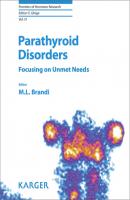Parathyroid Disorders. Группа авторов
Чтение книги онлайн.

Читать онлайн книгу Parathyroid Disorders - Группа авторов страница 5
Название: Parathyroid Disorders
Автор: Группа авторов
Издательство: Ingram
Жанр: Биология
Серия: Frontiers of Hormone Research
isbn: 9783318064094
isbn:
Other genetic disorders that should be considered in the differential diagnosis of PHPT include MEN1 and 2. Screening is justified in settings of familial glandular secretory syndromes that involve the pituitary glands and pancreas, or the thyroid or adrenal glands, or both. If the patient also has a history suggestive of MEN1 or 2, screening for these familial syndromes is important. The clinical presentation of parathyroid cancer is very different from the presentation of typical PHPT. Patients with parathyroid cancer tend to be younger by about a decade – between 40 and 50 years of age – and the prevalence is roughly the same in women and men. Serum calcium and PTH concentrations are usually much higher than in typical PHPT [6, 22].
Parathyroid imaging has become a standard preoperative procedure to locate abnormal parathyroid tissue [18]. The value of imaging rests with accurate identification of abnormal parathyroid tissue in order to assist in planning the appropriate parathyroid surgery. The imaging techniques most frequently used are 99mTc-sestamibi scintigraphy, ultrasound, and computed tomography (CT) [18]. In the presence of concordance between scintigraphy and ultrasound, the positive predictive value for correct side localization of a parathyroid adenoma can be as high as 97% [18]. 11C-methionine PET/CT scintigraphy is another method of imaging based on the uptake and incorporation of the essential amino acid methionine in parathyroid tissue in PTH synthesis. It may have a high sensitivity even in patients where conventional investigations have failed [18]. Magnetic resonance imagines may identify adenomas missed by sestamibi analysis. CT after contrast injection is a valuable imaging tool of particular benefit in localizing ectopic mediastinal parathyroid glands [18]. CT imaging allows the rapid assessment of the parathyroids. Disadvantages include the exposure to radiation, cost, and need for iodinated contrast [18].
Classical and Nonclassical Clinical Manifestations
Classically, PHPT targets the kidney and the skeleton. The extent to which a patient will present with overt involvement of these target organs varies depending on the availability of multichannel screening in a given country [18].
Skeletal Involvement
Radiographic signs of the PHPT include a salt-and-pepper pattern skull demineralization, distal clavicle tapering, subperiosteal bone resorption, cysts, and brown tumors. Together, these features are described as osteitis fibrosa cystica and are rarely seen in developed countries where more subtle forms of skeletal involvement are observed. A BMD measured by DXA (dual-energy X-ray absorptiometry) is usually low at the distal 1/3 radius and BMD should be measured at the 1/3 radius site in all individuals with PHPT [23]. An increase in fracture risk at all skeletal sites has been described [24]. High-resolution peripheral quantitative tomography has shown that both trabecular and cortical bone compartments are affected in patients with PHPT [18, 23]. The trabecular bone score, or TBS, which is able to predict the fracture risk independent of BMD [21], is consistent with a deteriorated trabecular microstructure and increased fracture risk [18, 25] in patients with PHPT.
Renal Involvement
Renal stones are a major complication of PHPT. Generally, patients with PHPT who develop renal stones are younger and more often male [18]. Hypercalciuria likely contributes to an increased risk of renal stones. The pathogenesis of increased renal stone formation in PHPT has not yet been fully elucidated. Hypercalciuria by itself does not fully explain the increased risk, and only limited data are currently available on the potential impact of other biochemical abnormalities, such as renal acidification abnormalities on the risk of stones in PHPT [18].
Nonclassical Clinical Manifestations
General symptoms – in particular, fatigue, weakness, anxiety, and mood alterations – along with impairment in quality of life may affect patients with PHPT and may or may not improve after surgical cure [4].
Peptic ulcer disease, which used to be considered a frequent complication of PHPT, is now rarely seen and is almost exclusively detected in patients with MEN1 or MEN4 syndromes, who can develop gastrin-producing tumors [4]. With regard to cardiovascular health, hypertension, premature atherosclerosis, valve calcification, left ventricular hypertrophy, and arrhythmias have been reported in patients with PHPT.
Table 2. Spectrum of clinical signs of hyperparathyroidism according to organ systems
| Central nervous systemFatigueDepressionMemory impairmentDementiaPsychosisComa |
| GastrointestinalPeptic ulcer diseaseCholelithiasisPancreatitisConstipation |
| SkeletalOsteopenia – osteoporosisFracturesBone cysts – brown tumors |
| Neuromuscular and articularMyopathyGout – pseudogoutChondrocalcinosisErosive arthritis |
| CardiovascularHypertension – left ventricular hypertrophyShortened QT intervalArterial stiffnessArrhythmiasVascular and cardiac calcifications |
| RenalPolyuriaUrine concentrating defectNephrolithiasisRenal tubular acidosis |
| OcularCataractsBand keratopathy |
Severe PHPT characterized by higher serum calcium levels (calcium ≥11.2 mg/dL) has been associated with an increased risk of cardiovascular mortality [18]. Table 2 shows the spectrum of clinical features of hyperparathyroidism according to the organ system.
Table 3. Indication for surgery in PHPT
| Age <50 years |
|
Serum calcium >1 mg/dL or >0.25
СКАЧАТЬ
|